Posted by Fran Jurga
In a previous entry, this blog provided details about the heel bulb
injury that predicated the disappointing retirement of champion three-year-old
Thoroughbred Big Brown. This post will give some background into the type of
injury for those unfamiliar with foot anatomy and injury.
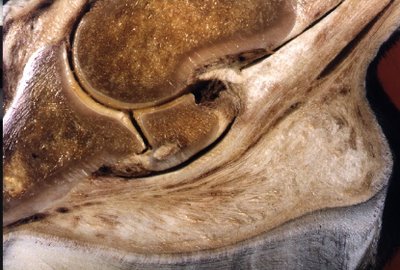
A horse's heel bulbs are similar to the fleshy part of the
palm of your hand above the wrist, at the base of your thumb. The bulbs are in
the back part of the foot, above the hairline and below the "waist"
of the pastern. In this photo, which shows a foot cut in half, it is the
brownish zone at the right that bulges out from the hoof. The heel bulbs are comprised
of soft tissue, namely the digital cushion, a fat-cartilage mass that fills out
the foot and provides multiple cushioning, circulation-enhancing and/or
structural functions in maintaining the integrity and strength of the foot. The
bulbs are covered with skin and hair and are not protected by hard hoof wall or
sole. They are a vulnerable structure. (Photo courtesy of HorseScience.com)
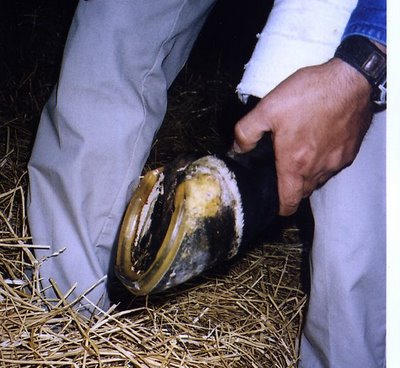
This stakes horse at Keeneland suffered a heel injury that
might have been similar to Big Brown's. Technically the heel bulbs are the area
covered with hair, just below the horseshoer's thumb. The area was filled in
and covered with acrylic and a glue on Polyflex shoe was applied by Curtis
Burns. This photo was taken when the horse was well into the healing process.
Sometimes the hind shoe scrapes down the back of the pastern over the heel
bulbs and ripping off part of the heel or pulling off the front shoe.
Thoroughbred racehorses frequently suffer from a grabbed quarter, heel bulb
lacerations and coronet bruising and cuts because of toe grabs on their shoes.
But, as Big Brown showed today, these injuries can occur even without toe
grabs. Frequently a hind foot comes up and strikes the front foot when there is
a gait abnormality, such as when horses are galloping on soft turf and the
front foot stays on the ground a fraction of a second too long and the hind
foot comes forward and strikes it. The injury frequently happens when horses
scramble out of the starting gate, and can happen to hind feet when
"clipping heels" with another horses. Some horses have conformational
or coordination problems that designate them "hitters" and suffer
from chronic lower leg and hoof injuries. They usually wear bandages, bell
boots and have their hind shoes "set back" to reduce the chance of
injury when training. Big Brown wore bell boots when schooling for the Belmont
to protect his quarter crack patch.
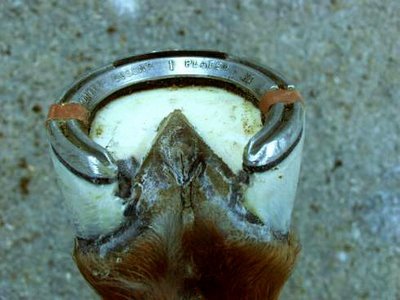
One of Big Brown's feet in the spring of 2008: His heel
bulbs are partially recruited into the hoof wall repair for his heel
separations. (Ian McKinlay photo)
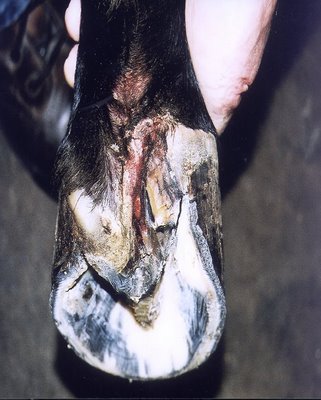
How bad can a heel bulb injury be? This is a case at the
Rood and Riddle Equine Hospital's Podiatry Clinic, as featured in issue #79 of
Hoofcare and Lameness Journal. Dr. Scott Morrison reconstructed the frog and
over time, was able to restore the foot and the young Thoroughbred began its
racing career wearing normal raceplates. Heel bulb injuries are common around
farms, particularly wire cuts, horses catching a hoof in a cattle guard,
pasture injuries, trailer loading mishaps, etc.
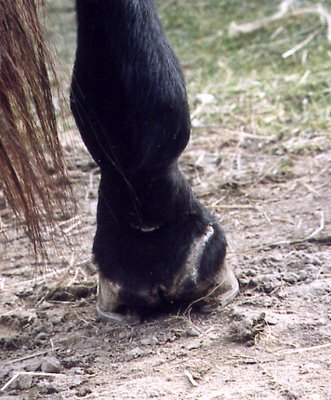
Aftermath of a heel bulb laceration: This ex-racehorse shows
evidence of a severe injury earlier in its life. The horse is completely sound.
This post was originally published on October 13, 2008 at
http://www.hoofcare.blogspot.com. Fran Jurga's Hoof Blog is a between-issues
news service for subscribers to Hoofcare and Lameness Journal.




